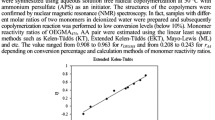Abstract
The radical copolymerizations of N-[(3-dimethylamino)propyl]methacrylamide (DMAPMA) with n-dodecyl acrylate (DA) or n-dodecyl methacrylate (DMA) in toluene (70 °C) were shown to have a peculiar nature: the total initial concentration of monomers significantly influences the composition and compositional heterogeneity of copolymers. Such processes can not be adequately described using the comonomer reactivity ratios. No concentration effects were found in the copolymerization of 2-(dimethylamino)ethyl methacrylate (DMAEMA) and n-dodecyl methacrylate in toluene; the calculated comonomer reactivity ratios were respectively 1.57 ± 0.20 and 0.83 ± 0.02. The differences in the behavior of systems involving amine monomers are related to the ability of DMAPMA to form assemblies with different reactivity due to the hydrogen bonding.







Similar content being viewed by others
References
Rudnick LR (2010) Lubricant additives: chemistry and applications, 2nd edn. Taylor & Francis, Boca Raton
Neveu CD, Sondjaja R, Stöhr T, Iroff NJ (2012) 10.26 - Lubricant and fuel additives based on Polyalkylmethacrylates. In: Krzysztof M, Martin M (eds) Polymer science: a comprehensive reference. Elsevier, Amsterdam, pp 453–478. doi:10.1016/B978-0-444-53349-4.00277-6
Pat. 6331603 US, US Cl. 526/307. Nitrogen Containing Acrylic Copolymers
Pang XA, Sun HM, Shen Q (2004) Copolymerizations of 2-(dimethylamino)ethyl methacrylate with (methyl)acrylates initiated by a neutral Pd(II)-based complex. Polymer 45(12):4029–4035. doi:10.1016/j.polymer.2004.03.064
Orbay M, Laible R, Dulog L (1982) Preparation of amide and amine groups containing copolymers of methyl methacrylate and their performance in solid polymer composites. Makromol Chem 183(1):47–63. doi:10.1002/macp.1982.021830104
Roy SG, Bauri K, Pal S, Goswami A, Madras G, De P (2013) Synthesis, characterization and thermal degradation of dual temperature-and pH-sensitive RAFT-made copolymers of N, N-(dimethylamino)ethyl methacrylate and methyl methacrylate. Polym Int 62(3):463–473. doi:10.1002/pi.4335
Camail M, Essaoudi H, Margaillan A, Vernet JL (1995) Copolymérisation radicalaire de méthacrylates de 2-aminoéthyle avec le méthacrylate de méthyle. Eur Polym J 31(11):1119–1125. doi:10.1016/0014-3057(95)00065-8
Hong SH, McHugh VM (1988) Review of polymerization and properties of aminoalkyl acrylates and aminoalkyl methacrylates. Technical report. Chemical Research, Development and Engineering Center, Aberdeen Proving Ground, MD. URL: www.dtic.mil/dtic/tr/fulltext/u2/a197705.pdf?
Miranda LN, Ford WT (2005) Binary copolymer reactivity of tert-butyl methacrylate, 2-(N, N-dimethylamino)ethyl methacrylate, solketal methacrylate, and 2-bromoethyl methacrylate. J Polym Sci A Polym Chem 43(19):4666–4669. doi:10.1002/pola.20939
Si K, Qiu KY (1995) Radical copolymerization of N-[(3-Dimethylamino)propyl] Acrylamide (or Methacyrlamide) with methyl acrylate (or Methacrylate). J Macromol Sci A 32(sup8):1139–1148. doi:10.1080/10601329508020335
López D, Plata P, Burillo G (1996) Effect of thermal treatment and radiation on (N, N-dimethylaminopropyl) acrylamide copolymers in the solid state. Radiat Phys Chem 47(2):251–256. doi:10.1016/0969-806X(94)00184-L
Kazantsev OA, Sivokhin AP, Samodurova SI, Kamorin DM, Orekhov DV (2012) Effect of the synthesis conditions on the compositional heterogeneity of copolymers of higher N-alkylacrylamides and butyl (meth)acrylate. Russ J Appl Chem 85(5):804–811. doi:10.1134/S1070427212050217
Kazantsev OA, Samodurova SI, Shirshin KV (2012) Effect of synthesis conditions on the compositional heterogeneity of copolymers of higher N-alkyl acrylamides and dodecyl (meth)acrylate. Plasticheskie massy (11):21–27, Russ
Kazantsev O, Shirshin K, Sivokhin A, Igolkin A, Goncharova O, Kamorin D (2012) Copolymerization of sodium 2-acrylamido-2-methylpropane sulfonate with acrylamide and acrylonitrile in water: an effect of conditions on the compositional heterogeneity. J Polym Res 19(6):1–10. doi:10.1007/s10965-012-9886-5
Myagchenkov VA, Frenkel' SY (1978) Topological principles of the analysis of binary statistical copolymerisation. Russ Chem Rev 47(7):665–683. doi:10.1070/RC1978v047n07ABEH002245
Kazantsev O, Samodurova S, Sivokhin A, Goncharova O, Kamorin D, Shirshin K, Orekhov D (2013) Homopolymerization of higher alkyl (meth)acrylates and N-alkyl acrylamides in toluene: an effect of monomer self-organization. J Polym Res 20(1):1–6. doi:10.1007/s10965-012-0052-x
Fineman M, Ross SD (1950) Linear method for determining monomer reactivity ratios in copolymerization. J Polym Sci 5(2):259–262. doi:10.1002/pol.1950.120050210
Chapiro A, Perec-Spritzer L (1975) Influence des solvants sur la copolymérisation de l’acrylamide avec l’acrylonitrile. Eur Polym J 11(1):59–69. doi:10.1016/0014-3057(75)90176-7
Barton D, Ollis WD (1979) Comprehensive organic chemistry, vol 2. Pergamon Press, Oxford
Kabanov VA, Zubov VP, Semchikov YD (1987) Kompleksno-radikal’naya polimerizatsiya. Khimiya, Moscow
Seabrook SA, Tonge MP, Gilbert RG (2005) Pulsed laser polymerization study of the propagation kinetics of acrylamide in water. J Polym Sci A Polym Chem 43(7):1357–1368. doi:10.1002/pola.20605
Ganachaud F, Balic R, Monteiro MJ, Gilbert RG (2000) Propagation rate coefficient of Poly(N-isopropylacrylamide) in water below its lower critical solution temperature. Macromolecules 33(23):8589–8596. doi:10.1021/ma000619l
Platé NA, Ponomarenko AG (1974) Vysokomolekulyarnyye soyedineniya. Seriya A 16(12):2635–2645, Russ
Korolev G, Perepelitsina E (2001) Kinetic anomalies in the radical polymerization of alkyl (Meth)acrylates and their quantitative interpretation in terms of the associated cluster model. Polym Sci A 43(5):474–483
Myagchenkov VA, Kurenkov VF (1991) Polym Plast Technol Eng 30(2–3):109–135
Acknowledgments
This work was financially supported by the Russian Foundation for Basic Research (project 12-03-31702-mol_a).
Author information
Authors and Affiliations
Corresponding author
Rights and permissions
About this article
Cite this article
Kazantsev, O.A., Kamorin, D.M., Sivokhin, A.P. et al. Copolymerization of amine-containing monomers and dodecyl (meth)acrylate in toluene: controlling compositional heterogeneity. J Polym Res 21, 353 (2014). https://doi.org/10.1007/s10965-013-0353-8
Received:
Accepted:
Published:
DOI: https://doi.org/10.1007/s10965-013-0353-8




